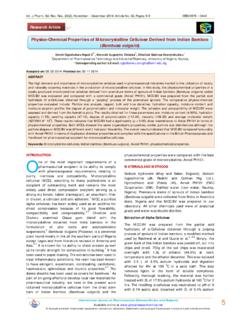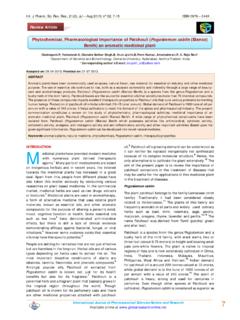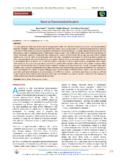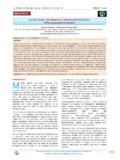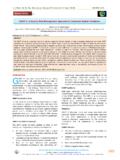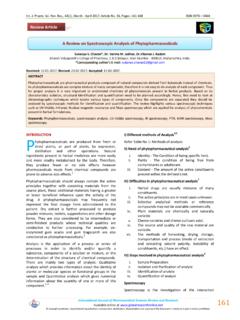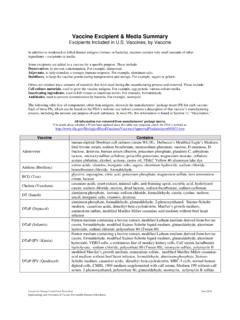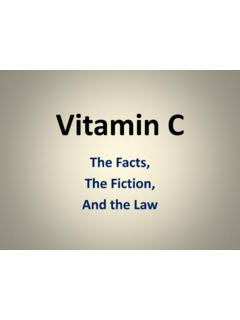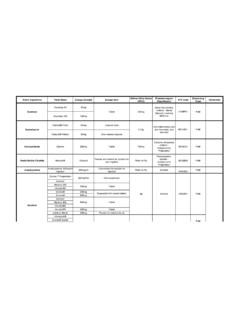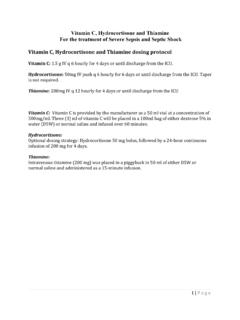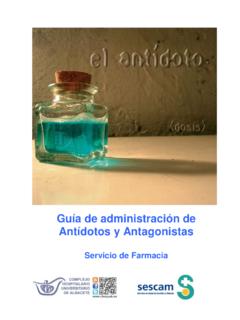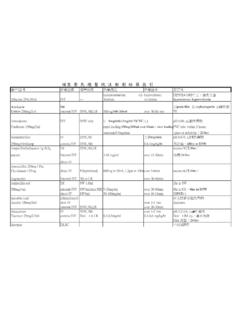Transcription of AN UPDATED REVIEW ON TRICOSANTHES CUCUMERINA L
1 Volume 1, Issue 2, March April 2010; Article 011 ISSN 0976 044X. AN UPDATED REVIEW ON TRICOSANTHES CUCUMERINA L. *Sandhya S, Vinod , J. Chandra Sekhar, R Aradhana, Vamshi Sarath Nath Department of Pharmacognosy, Nalanda college of Pharmacy, Nalgonda (dt), AP, India - 508001. *Email: ABSTRACT. The universal role of plants in the treatment of diseases is established by their employment in all important systems of medicine. There are many herbs on earth which lies unexplored in the field of medicine or Science. One such plant is Trichosanthes CUCUMERINA which is known as snake gourd, viper gourd, snake tomato or long tomato. The fruit is usually consumed as a vegetable due to its good nutritional value. The plant is rich in flavonoids, carotenoids and phenolic compounds.
2 Trichosanthes CUCUMERINA has a promising place in the Ayurvedic and Siddha system of medicine due to its various medicinal values like antidiabetic, hepatoprotective, cytotoxic, anti inflammatory, larvicidal effects. In the present REVIEW the complete update on the plant has been enlightened to bring out the hidden medicinal values of the plant. Key Words: Trichosanthes CUCUMERINA , cucurbitacin, hydragogue, hemagglutinant, anti-ovulatory. INTRODUCTION Ab bora-serpente in Portugal, K rmekurkku in Finland, Buap nguu Ma noi in Thailand, Yilan kabagi in Turkey, A complete understanding of medicinal plants involves a Calabaza anguina in Spain. number of factors like botany, chemistry, genetics, quality control and pharmacology.
3 In addition there is a large Description wealth of knowledge in the medicinal and other properties TRICOSANTHES CUCUMERINA is a monoecious annual herb of plants from generation to generation by the tribal climbing by 2 3-branched tendrils upto 5 to 6 meters high societies1. TRICOSANTHES CUCUMERINA is a well known plant, or less. The stems are slender, green, 4-angled, somewhat the fruit of which is mainly consumed as a vegetable. It is hairy, and faintly disagreeable in odor. The roots are an annual climber belonging to the family Cucurbitaceae. somewhat tuberous and whitish. The leaves are alternate, It is commonly called as snake gourd, viper gourd, snake simple with no stipules. Leaves are scabrid hairy on both tomato or long tomato.
4 The fruit is usually consumed as a surfaces, rounded in outline, 7 to 14 centimeters long and vegetable due to its good nutritional value. The plant is broad, and 3 or 5-lobed, the lobes being broad, rounded or richly constituted with a series of chemical constituents obtuse, and the sinuses broad or narrow and rounded. The like flavonoids, carotenoids, phenolic acids which makes base is broadly The staminate the plant pharmacologically and therapeutically active. It inflorescences are long-peduncled and axillary, with six to has a prominent place in alternative systems of medicine fifteen flowers. Flowers are unisexual, regular, and white like Ayurveda and Siddha due to its various in colour with green and hairy calyx.
5 Corolla is tubular in pharmacological activities like antidiabetic, with lobes fringed and hairlike outgrowths. The male hepatoprotective, cytotoxic, anti inflammatory, larvicidal flowers are many-flowered with axillary racemes on 10 . 30 cm long peduncles. They are with 3 stamens but the TRICOSANTHES CUCUMERINA falls under the scientific female flowers are solitary and sessile with inferior, single classification of celled ovary, long and with hairy stigmas. Fruits are very slender, long and cylindrical berry, often twisted, Kingdom: Plantae greenish-white when immature, dark red when mature. Division: Magnoliophyta The seeds are half-ellipsoid, somewhat compressed, undulate, hard, rugose, nearly one centimeter long, Class: Mangnoliopsida greyish-brown, sculptured, margin undulate and imbedded Order: Curcubitales in a soft foetid with red Family: Curcubitaceae Origin and distribution Genus: Trichosanthes The genus Trichosanthes is native to Southern and Eastern Asia, Australia and Islands of the western Pacific.
6 Species: CUCUMERINA Trichosanthes CUCUMERINA is found wild throughout these The regional names of snake gourd or snake tomato is areas. It was probably domesticated in ancient times in called in Bengali as Chichinga/ Chichinge, in Telugu as It is grown as a minor vegetable in many countries potlakaaya, in Tamil as pudalankaai, in Kannada as of tropical Asia. It is locally grown as a vegetable in home aduvalakaayi, in Malayalam as padavalanga, Galartori in gardens in Africa. Commercial growers around big cities Punjabi, padavali in Gujarathi, Chachinda in ,4 in East Africa occasionally grow cultivars of snake gourd imported from India for people of Indian origin. It is also In other nations it is commonly called as serpent veg tal in reported from India through Malaya to tropical Australia.
7 France, Schlangengurke in Germany, Karasu-uri-zoku in Japan, Patola in Srilanka, Zucchetta cinese in Italy, International Journal of Pharmaceutical Sciences REVIEW and Research Page 56. Available online at Volume 1, Issue 2, March April 2010; Article 011 ISSN 0976 044X. Trichosanthes CUCUMERINA is a newly introduced crop of O. increasing importance in several parts of Africa, including OH. Ghana and Nigeria. The genus Trichosanthes comprises about 100 species, of which a few have been domesticated OAc in Asia, snake gourd being the most important. Two O. varieties are distinguished within Trichosanthes OH. CUCUMERINA . They are the wild var. CUCUMERINA occurring from India, Sri Lanka and China, through South-East Asia, HO.
8 To northern Australia, and the cultivated var. anguina (L.). Only traditional landraces of Trichosanthes CUCUMERINA are used in West and Central Africa, whereas improved cultivars from India are grown in East It is O. distributed in temperate Asian regions like china, tropical regions of Bangladesh, India, Nepal, Pakistan Sri Lanka, Cucurbitacin B. Myanmar; Vietnam, Indonesia; Malaysia; Philippines, in Australia it is found in Northern Territory, Queens land and in Western Australia. O. OH. Phytochemicals TRICOSANTHES CUCUMERINA is a rich source of nutrition. It is OAc highly constituted with proteins, fat, fibre, carbohydrates, O. vitamin A and E. The total phenolics and flavonoids OH. content is and respectively7.
9 The fruit is rich in Vitamin C and E. The crude protein content is HO. The predominant mineral elements were potassium ( 100-1g) and phosphorus ( 100-1g). Other elements found in fairly high amounts are Sodium, O. Magnesium and Zinc9. The triterpenes found are 23, 24-dihydrocucurbitacin D, 23,24-dihydrocucurbitacin B, cucurbitacin B, 3 -hydroxy- Cucurbitacin E. olean-13(18)-en-28-oic acid, 3-oxo-olean-13(18)-en-30- oic acid and the sterol 3-O- -D-glucopyranosyl-24 -ethyl- O. cholest-7,22-dien-3 The percentage free fatty acid OH. and acid values were low suggesting increased stability and usefulness in nutritional and industrial applications10. OAc O. The chemical constituents present in are OH. cucurbitacin B, cucurbitacin E, isocucurbitacin B, 23,24- O.
10 Dihydroisocucurbitacin B, 23,24-dihydrocucurbitacin E, sterols 2 -sitosterol stigmasterol 11. Low amount of chemical substances like oxalate, phytates and tannins are HO. also present. Analysis showed that the seed of T. CUCUMERINA have high oil content up to 5%. The presence of common protein bands among the species may Isocucurbitacin B. be an evidence of evolutionary origin and many protein bands found to be unique in the Trichosanthes CUCUMERINA O. suggested that there is no genetic relationship with OH. Lycopersicon12. A galactose-specific lectin and ribosome-inactivating OAc protein named trichoanguin13 are present in aerial O. parts14,15. The bulk of carotenoids made of lutein is present OH. in the concentration of mg/100g FW15.

